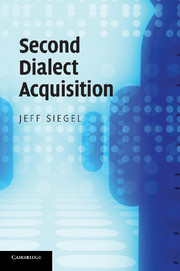Book contents
- Frontmatter
- Contents
- List of figures
- List of tables
- Acknowledgements
- List of abbreviations
- 1 Introduction
- 2 Attainment in naturalistic SDA
- 3 Acquiring a second dialect
- 4 Differential attainment: Age effects and linguistic factors
- 5 Additional individual and linguistic factors
- 6 The difficulty of SDA
- 7 SDA in classroom contexts
- 8 Educational approaches for SDA
- 9 Explaining the results and taking further steps
- Notes
- References
- Index
1 - Introduction
Published online by Cambridge University Press: 07 September 2010
- Frontmatter
- Contents
- List of figures
- List of tables
- Acknowledgements
- List of abbreviations
- 1 Introduction
- 2 Attainment in naturalistic SDA
- 3 Acquiring a second dialect
- 4 Differential attainment: Age effects and linguistic factors
- 5 Additional individual and linguistic factors
- 6 The difficulty of SDA
- 7 SDA in classroom contexts
- 8 Educational approaches for SDA
- 9 Explaining the results and taking further steps
- Notes
- References
- Index
Summary
This book is about learning a new dialect, and how it is different from learning a new language. In this introductory chapter, I start by describing the contexts where this kind of learning occurs and some of the questions the book aims to answer. As I have tried to make the content accessible not just to linguists, I have also included some basic information for readers without a strong background in linguistics. This is about differentiating dialects, describing speech sounds and studying variation in language. The final section presents a brief outline of the book.
Second language acquisition and second dialect acquisition
The study of second language acquisition (often abbreviated as SLA) examines how people who already speak a first language (L1) subsequently acquire a second or additional language (L2). This book focuses on a special type of SLA – when the relationship between the L1 and the L2 is close enough for them to be considered by their speakers to be varieties of the same language, or different dialects, rather than different languages. In this situation, the term “second dialect acquisition” (SDA) can be used. The study of SDA examines how people who already speak one dialect (D1) acquire a different dialect (D2) of what they or their community perceive to be the same language.
Of course it is notoriously difficult to distinguish language and dialect.
- Type
- Chapter
- Information
- Second Dialect Acquisition , pp. 1 - 21Publisher: Cambridge University PressPrint publication year: 2010

